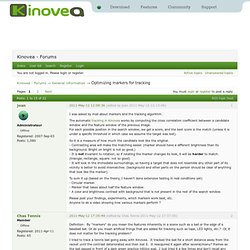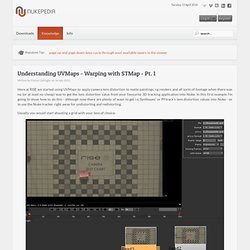

Photon 3D Scanner.
Eric Alba Blog - Lens Distortion Grids (pdf) for download. Updated with Camera department documentation. #vfx #cinematography. 48 inches by 96 inches PDF files.

You can print these at Fedex/Kinko’s, laminate them etc. You can scale these if you want a bit of a margin for rigging/mounting. View Single Post - PfTrack focal length input with RED ONE. One question I am uncertain about is the input of focal length and film back. What numbers are used and why? I found this link that has some great information: --This is a good place to start Following that I use Frame aspect: 2 --RightPrincipal point: 49 and 49 --Probably wrong, I don't know where you got the 49 number here. The principal point is basically the frame offset from camera lens center. PFTrack Camera parameters for RED ONE. Pftrack focal length sensor cropped field of view. Pftrack stationary camera. Vfx tracking marker closeup / now you can download /IMG_0958. VFX Kit (gallery) - Eric Alba / Visual Effects & Post-Production Supervisor NYC / 310.947.8502 / 24 Lies Per Second.
Art of Tracking Part 2: Tips & Apps Overview. In part 2 of the Art of Tracking series, we take a look at the various software applications for 2D and 3D tracking.
The software developers of these apps give us some technical insight as well as tips and suggestions how to get great tracks. 2D Tracking In looking at what tracks and how it is important to understand one key point, most modern trackers with the exception of Digital Fusion (and to a lesser degree Shake and AE) have all moved away from colour processing approaches. Almost all trackers are now biased to a luminance of black and white version of the track box. Digital Fusion alone amongst the leading packages uses colour information automatically. Digital Fusion also has another very innovative feature. Shake also offers the ability to use hue or saturation for tracking instead of luminance. Tracking now exists in every aspect of visual effects and is moving into colour grading. Forums / Optimizing markers for tracking. I have just a little experience using markers for high speed film imaging and almost no experience for sports applications or tracking.

No internet search yet so there may be many markers that I’m not familiar with. This thread could use some advice on marker options from those who have professional experience selecting markers for high speed video in biomechanical research. 1) Tape. Contrasting tape placed in reference locations. If applied to the body one issue is that the tape may not move with the bones due to muscles bouncing, etc. Crop Factor. Home Donate New Search Gallery How-To Books Links Workshops About Contact Crop Factor © 2009 KenRockwell.com 35mm film marked with digital camera sensor sizes.

(Green: Canon 1.3x, Red: Nikon DX, Blue: Canon 1.6x. Nikon FX and Canon full-frame are the same size as the image in the film.) Panavision NZ Film,Video and Photography Frames & Formats, aspect Ratios and dimensions. Cropped sensor & Focal Length. Lens Distortion - PFTrack to Nuke - Page 3. Understanding UVMaps - Warping with STMap - Pt. 1 - Written Tutorials. Here at RISE we started using UVMaps to apply camera lens distortion to matte paintings, cg renders and all sorts of footage when there was no (or at least no cheap) way to get the lens distortion value from your favourite 3D tracking application into Nuke.

In this first example I'm going to show how to do this - although now there are plenty of ways to get i.e. Syntheyes' or PFtrack's lens distortion values into Nuke - or to use the Nuke tracker right away for undistorting and redistorting. Usually you would start shooting a grid with your lens of choice: Then you would undistort it using the 3D tracking software (please note the increase of image size due to warping): You can now use your undistorted footage in your 3D application of choice as background and all track predictions will stick perfectly (as long as your 3D camera's focal length takes the overscan image size into account). Part 1: Creating Clean Plates. Anyone use PFTrack before? - Page 2. The Pixel Farm News - PFTrack and PFMatchit 2012.1.
Marking the first of several releases scheduled for this year under the new annual software maintenance scheme, new features in PFTrack and PFMatchit 2012.1 include: PFBarrel for Nuke Previously only available for Shake, PFBarrel for Nuke significantly enhances the lens workflow between The Pixel Farm's products and The Foundry's Nuke compositing application.
Lens data exported from PFTrack and PFMatchit is imported directly into Nuke through the PFBarrel plugin.All calibrated lens data to be manipulated and utilized in a number of ways. The most obvious use of PFBarrel is to apply the dynamics of the original lens to rendered CG layers when compositing them with the live action plate.Available to download free of charge.Requires a 2012 version of PFTrack or PFmatchit New Mask Tools. Relation between Nuke and Pftrack's Distortion Parameters. Bookings. Canon EOS 7D ISO Noise test. » Best ISO for low noise on Canon 5D mk2 - from QT Luong's Blog. What ISO should you use for lowest noise ?

Everybody knows that low ISO will result in lower noise and high ISO will result in higher noise. But is it a continuum, as one would intuitively think, or are some ISOs better than others ? In the past, I had seen advise to use only whole f-stop ISOs (100,200,400,800,1600,…) because intermediate ISOs were presumably “interpolated” and therefore worse. I recently watched part of a DSLR Video online class given by Vincent Laforet for creativeLIVE. There was plenty to learn on the video side. This picked my interest enough that I decided to conduct a “scientific” test myself. I photographed a Kodak Q13 greyscale with a Canon 5Dmk2, using ISO values from 50 to 6400. The following graph attempts to summarize the results with a single number, the luminance (Y) noise in pixels. Here are what we can read from the graph: Exporting camera to nuke?
The Pixel Farm. Review: Pixel Farm's PFMatchit.